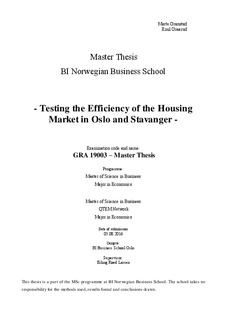Testing the Efficiency of the Housing Market in Oslo and Stavanger
Master thesis
Permanent lenke
http://hdl.handle.net/11250/2444383Utgivelsesdato
2016Metadata
Vis full innførselSamlinger
- Master of Science [1621]
Sammendrag
Our research tests the efficiency hypothesis on data from the housing market in Oslo and Stavanger, covering the period 2002-2014. We utilize the Case-Shiller time structure test on a repeated sales house price index and examine the excess return time series for housing investments for each city. This paper is mainly a replication of the research carried out by Røed Larsen and Weum in 2008,1 it does, however, offer some modifications and extensions.
We conclude that both the repeated sales house price index and the excess return to housing does not contain time structure in any of the cities, and hence the housing markets are characterized as efficient. This is in contrast to the previously concluded inefficiency in Oslo from 1991-2002 by Røed Larsen and Weum. It is quite interesting that the housing market in Oslo has evolved from inefficient to efficient when comparing the last two decades. This paper does not provide an in-depth analysis of outside factors that may have contributed to these changes, as we leave that to further research. It gives, however, a solid conclusion of efficiency in the Oslo and Stavanger housing market for the relevant period. We demonstrate that the stock market consistently yields higher appreciation and higher volatility than both the housing markets in the period of 2002-2014, which is a contrast to the previous research. The housing markets appear to yield the highest risk-adjusted return.
Beskrivelse
Masteroppgave(MSc) in Master of Science in Business, Economics - Handelshøyskolen BI, 2016
